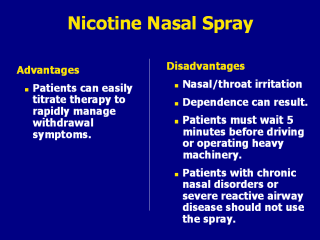| front |1 |2 |3 |4 |5 |6 |7 |8 |9 |10 |11 |12 |13 |14 |15 |16 |17 |18 |19 |20 |21 |22 |23 |24 |25 |26 |27 |28 |29 |30 |31 |32 |33 |34 |35 |36 |37 |38 |39 |40 |41 |review |
 |
Advantages of the nicotine nasal spray include
the following: The dose can be easily titrated to rapidly manage withdrawal symptoms. Disadvantages of the nasal spray include the following: The initial nasal or throat irritation can be bothersome; it may take up to 3 weeks for the patient to tolerate therapy. Dependence can result. The nicotine nasal spray has a dependence potential intermediate between tobacco products and other NRT products. About 15–20% of patients continue to use the nicotine nasal spray for longer periods than recommended (6–12 months), and 5% use the spray at higher doses than recommended (Fiore et al., 2000). Patients should wait 5 minutes before driving or operating heavy machinery (due to the potential for tearing, coughing, and sneezing). Patients with chronic nasal disorders (e.g., rhinitis, polyps, sinusitis) or patients with severe reactive airway disease should not use the nicotine nasal spray because of the irritant effects of the spray. Asthma exacerbation has been noted in some patients after administration of nicotine nasal spray. Fiore MC, Bailey WC, Cohen SJ, et al. Treating Tobacco Use and Dependence. Clinical Practice Guideline. Rockville, MD: U.S. Department of Health and Human Services, Public Health Service, 2000. Slide is used with permission, Rx for Change: Clinician-Assisted Tobacco Cessation. Copyright © 1999-2007 The Regents of the University of California, University of Southern California, and Western University of Health Sciences. All rights reserved. |